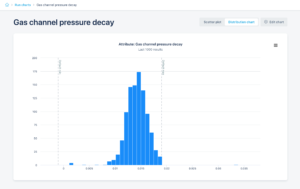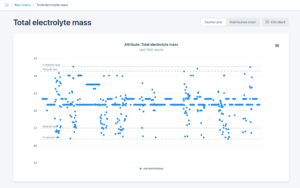Battery manufacturers can experience failure rates of up to 20% or more for pilot lines or up to 5% or more for production lines, leading to increased costs and lost productivity. What are some of the reasons you see for this?
One of the main challenges with liquid electrolyte chemistry is the leak issue. Typically, in manufacturing processes, batteries of this kind are infrared welded to keep the electrolyte intact. Some failure points can include, for example:
- Leak failures due to out of spec frames causing incorrect welding or welds giving up during vibration
- Welding inaccuracies attributed to inadequate heat at the joints
- Frames not contacting due to lack of pressure applied
- Welders needing calibration individually (where global settings are inadequate)
Welders generate data points, but it’s often not adequately captured or gets lost and thus not usable for analysis. This is an important part of our Battery Intelligence platform, which has been used to capture 94% or more of data generated in the entire manufacturing process for metrics and analytics.
In some cases, failures in welding are detected using leak testing methods after the cooldown period or even further down the line when a battery is filled with electrolyte. This results in scrapping a battery, and potentially larger production delays and more expensive re-work.
It sounds like in many cases battery defects during manufacture aren’t detected until the point where a battery needs to be scrapped, leading to higher costs and lost time. Can you give an example of a manufacturer that was having this problem and how they solved it?
With one of our customers, in looking back at scrapped battery metrics, we noticed a trend where batteries welded in a specific set of welders were scrapped more often compared to others. This set of welders was from a different manufacturer and didn’t provide weld data to detect the issue earlier on. As a result, batteries from this welder were 2.5x more prone to be scrapped. In this case, shutting down problem welders to avoid scrapping was the solution.
Part of our Battery Intelligence offering provides customers with manufacturing insights based on a cloud-based, real-time view of production line data. Run charts highlight data points that are above/below the threshold set, allowing supervisors or operations managers to make data-driven decisions on how to improve the process and isolate problem areas. For example, manufacturing supervisors or operations managers can stop the line when they see a trend in the run charts that denotes a problem where calibration is needed.
This is a great example of how data-driven decisions can directly impact manufacturing yield and overall quality. You mentioned the “Manufacturing Insights” offering. Can you give a little more detail on what that looks like? What other sorts of uses can it serve?
With Manufacturing Insights, data points are plotted as run charts as a battery progresses through the manufacturing line. Here we highlight when data points exceed the limit set in the process, giving the supervisor a quick heads up on trends that can lead to potential problems, down to the individual cell block.
Below are some examples of run charts generated by Manufacturing Insights, which illustrate some of the impacts they had on the manufacturing process.

As part of the Manufacturing Insights module, this chart allows line operators and supervisors to plot the length of batteries coming off the assembly line.

This distribution chart allows line operators and supervisors to analyze pressure decay test results in another view. The chart should appear as a bell curve, allowing outliers to be identified easily, and indicating where further drill-down is required.
This chart indicates that the electrolyte fill nozzle needed some calibration where fill mass is wavering, which is expected to be an almost straight line after fixing it.
In trying to catch manufacturing issues as batteries proceed down the line using data available to them, what common mistakes do you see most companies make?
Manual data capture is one of the biggest issues. While every manufacturer understands the need for data capture on some level, manual data capture – usually with “paper travelers” or simple paper checklists – can lead to problems such as human error, missing decimal precisions, incorrect units, missing values, and illegibility. Perhaps most important, this data is useful only to the person who records it, since it’s not searchable or usable for critical downstream analysis.
Similar issues happen when data is captured in Excel or other tools, since it then becomes siloed in one machine (or a folder on a shared drive) and not available to analysts on a real-time basis. This leads to time delays before a problem gets identified and corrected, and potentially a higher percentage of scrapped products. While it’s good that data is captured digitally, manual entry in a localized format introduces inefficiencies and hinders data insights.
If we go past the above two issues and implement proper online data capture from PLC machines directly for analysis, the next problem area we see is not having enough data points or parameters captured to identify the root cause of an issue. Manufacturers, for example, may only capture data points from the final test results as the battery comes off the line. If these results show values beyond threshold limits, you have very little insight into what might have contributed to the issue. How do we pinpoint and identify the root cause in this case? It’s often too late. For example, if a PLC machine reports pressure or volume data as zero values, is it a machine problem or is the value actually zero? Is there even a dry run/test procedure to collect PLC machine parameters and results?
When we work with customers, they are understandably eager to quickly get to the “predictive analytics” stage where issues on the assembly line are identified and solved in real-time. While this is indeed the end goal, it’s only possible if significant effort has been made to gather, parameterize, and normalize the entirety of available data, often across work functions and departments depending on the company size. This can be a painful step for many companies where it makes more sense to partner with someone who has done it before successfully and can act as a change agent to drive a common vision across the organization.


